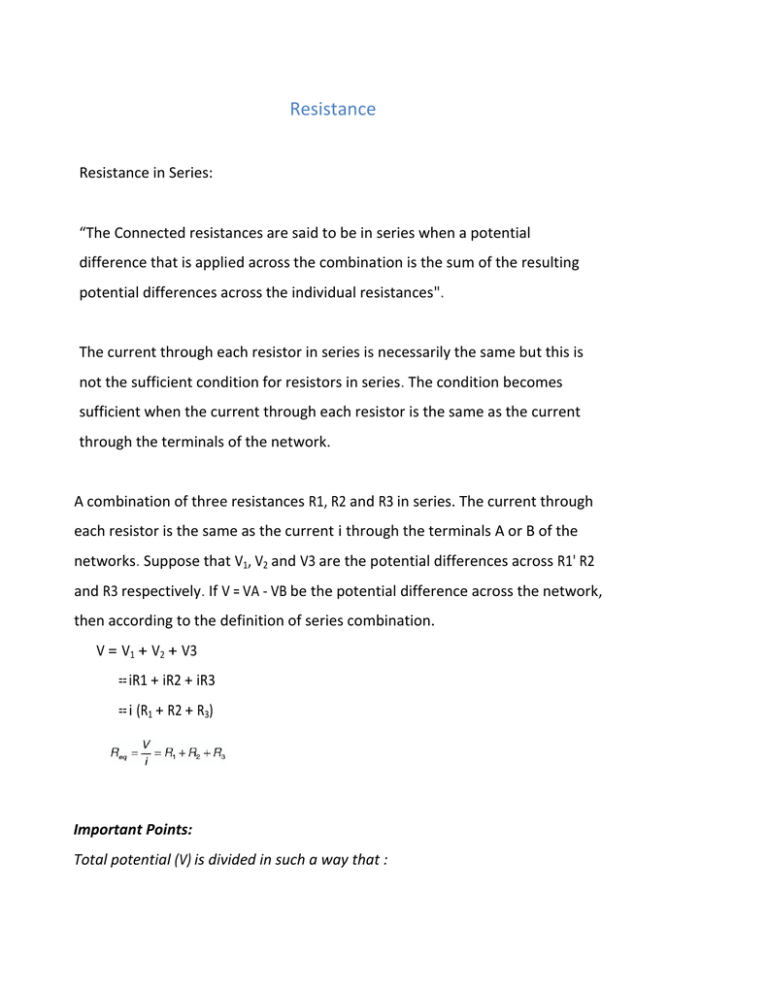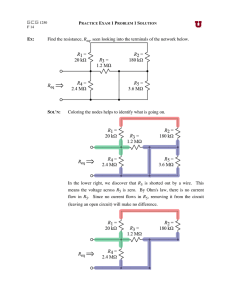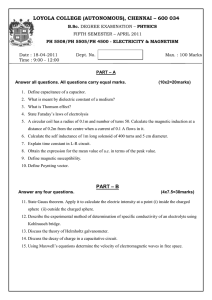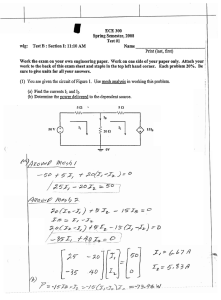Resistance
advertisement

Resistance
Resistance in Series:
“The Connected resistances are said to be in series when a potential
difference that is applied across the combination is the sum of the resulting
potential differences across the individual resistances".
The current through each resistor in series is necessarily the same but this is
not the sufficient condition for resistors in series. The condition becomes
sufficient when the current through each resistor is the same as the current
through the terminals of the network.
A combination of three resistances R1, R2 and R3 in series. The current through
each resistor is the same as the current i through the terminals A or B of the
networks. Suppose that V1, V2 and V3 are the potential differences across R1' R2
and R3 respectively. If V = VA - VB be the potential difference across the network,
then according to the definition of series combination.
V = V1 + V2 + V3
== iR1 + iR2 + iR3
== i (R1 + R2 + R3)
Important Points:
Total potential (V) is divided in such a way that :
V1 : V2 : V3 == R1 : R2 : R3
Or,
If R1= R2 =R3 then V1= V2 = V3= V/3 and Req =3R
Similarly, if there are n resistors in series,
Req=R1 +R2+ .. + Rn
If R1= R2 =R3' then V1= V2 = V3= V/3 and Req =3R
, Similarly, if there are n resistors in series,
Req=R1 +R2+ .. + Rn
RESISTANCES IN PARALLEL
The connected resistances are said to be in parallel when a potential
difference that is applied across the combination is the same as' the
resulting potential difference across the individual resistances. It shows
three resistances in parallel V = potential difference across each resistor =
potential difference across the combination between A and B
The currents in three resistances are:
i1 =
V
V
V
,i =
and i3 =
R1 2
R2
R3
The total current is
Or, V = V + V + V
Req
R1
R2
R3
Or, 1 = 1 + 1 + 1
Req
R1
R2
R3
For n resistors in parallel,
1 =1 +1 + +1
...
Req R1 R2
Rn
For two resistors in parallel,
1 = R1 R2
Req R1 + R2
(i) here equivalent resistance is less than each of the individual
resistance.
(ii) i1 : i2 : i3 = 1 : 1 : 1
R1 R2 R3
Example. What is the equivalent resistance between two points A and B?
Solution:
Taking R2 and R3 in parallel, the resulting
will be as following.
Now, equivalent resistance will be in series combination.
. . Req = R1 + R + R4
= (2 + 2+ 2) Ω = =6Ω
ELECTRIC CURRENT AND KIRCHHOFF'S LAW
Internal Resistance: Every source of emf has a resistance of its own, known
as the internal resistance (r). For example, in case of a cell, the components
inside it offer a resistance to the flow of current. The value of the internal
resistance of a cell depends on: (a) the surface area of its electrodes, (b) the
separation between them and (c) the nature, concentration and temperature
of its electrolyte.
A simple electric circuit
When a current i flows through C, the source C does work to transfer positive
charge from one end A to the other end B. lf E is the emf of the cell and r its
internal resistance, then a part v
of
E is used up in transferring
charge from A to B. From Ohm's law, this part is given by
v = ir
... (i)
The remaining part V = (E - v) drives the charge through the external resistor
R; this part is given by
V = iR
... (ii)
I
Now, E = V + v
... (iii)
Equations (i) to (Hi) give
ER
V
R
" =
E R+r
(R + r)
E-V = E-V
Also, i =
..... (iv)
R
r
E - V = (E - V)
or r =
R
i
V
E - V = ir ... (v)
V=
Notice from Equation (iv) that if i = 0 E = V, i.e., if no current is drawn from the ell
(i.e., in an open circuit), the potential difference V across its terminals equals its
emf E. If ≠ 0, V is less than E.
From (v), E=V, when r = O, V < E. lf r ≠O
Kirchhoff's Rules: Kirchhoff found two rules for determining the current and
resistance in a complicated circuit. These laws are as follows:
1. In an -electric circuit-the algebraic sum of the currents meeting at any
junction in the circuit is zero, that is ∑I = 0
When applying this law, the current going towards the junction is taken as
positive while that going away is negative. In the following
11 + 13 - 12 - 14 -Is = 0
(a) and (b)
or 11 + 13 = 12 + 14 + Is
Thus the sum of the currents flowing toward the junction is equal to the sum of the
currents flowing away, from the junction. Therefore, when a steady current flows
in a circuit then there is neither any accumulation of charge at any point in the
circuit nor any depletion of charge from there. Thus, Kirchhoff's first rule expresses
the conservation of charge.
2. In any closed mesh of a circuit, the sum of the products of the current and
the resistance in each part of the mesh is equal to the algebraic sum of the
e.m.f.'s in that mesh, that is, ∑(IR) = ∑E
In applying this law, when we traverse in the direction of current then the
product of the current and the corresponding resistance is taken as
positive, and the e.m.f. is taken as positive when we traverse from the
negative to the positive electrode of the cell through the electrolyte.
Applying Kirchhoff's" rule to mesh 1, (or closed mesh ABFGA)
l1 R1 - l2 R2 = E1 - E2
Similarly, for the mesh 2, (or closed mesh BCDFB) we have
l2 R2 + (l1 + l2)R3 = E2
From these equations, we can determine the values of currents in different
parts of the circuit.
Grouping of Cells: A cell is a source of electric current. A single cell cannot give a
strong current.
Therefore, to get strong current two or more cells are to be combined. The
combination of cells is called a 'battery'. Cells can be combined in three
ways: (a) In series, (b) In parallel and (c) In mixed grouping.
1. In series: In this combination, the negative pole of the first cell is
connected to the positive pole of the second cell, the negative pole of the
second. to the positive pole of the third, the negative pole of the third to the
positive pole of the fourth, and so on
Suppose, n cells each of e.m.f E and internal resistance r are connected in
series. These cells are sending current in an external resistance R. Then,
Total e.m.f of the cells = n E
Total internal resistance = n r
Therefore, Total resistance of the circuit = (nr + R)
If the current in the circuit be l, then = I =
nE
(nr + R)
Important Points:
1. If r« R, then from eq. (i) I = nE
R
(approx,) that is, if the internal resistance of the connected
cells is much smaller than the external resistance, then the current
given by these cells will be nearly n times the current given by one
cell. Hence, when the internal resistance often connected cells is
much smaller than the external resistance, then the 'cells should be
connected
in series to obtain it strong current.
2. If nr » R, then, I = nE = E (approx), that is, if internal resistance
R
r
of the connected cells is much greater than the external resistance,
then nearly the same current is obtained by single cell. Hence, there
is no advantage of connecting cells in series.
3. If in series grouping of n cells, n1 cells are reversed then
Eeq = (n- n1)E - n1E
= (n - 2n1)E and req = nr
So I = (n - 2n1) E
R + nr
2. In Parallel: In this combination, the positive poles of all the cells are
connected to one point, and the negative poles to another point . Suppose
m cells, each of e.m.f. E and internal resistance r, are connected in parallel
and this battery of m cells is connected to an external resistance R. Since
the
cell are connected in parallel, the e.m.f. of the battery will also be E. If the
equivalent internal resistance of the cell be R1,
then
1 = 1 + 1 + ..... upto m terms = m or R = r
1
R1 r r
r
m
Therefore, Total resistance of the circuit = (r/m + R). If the current in the
external circuit be l,
Then, l =
E
= mE
(r/m) + R r + mR
Important Points:
i.
If r<<R, that is, if the internal resistance of the cells is much
smaller than the external resistance, then r can be
neglected in comparison to mR. Then, from eq. (i), l = E/R
(approx.), i.e., total current will be equal to the current
given by a single cell. Hence, there is no advantage of
connecting the cells of small internal resistance in
parallel.
ii.
If (r/m)>>R, that is, if the internal resistance of the cells in
larger than the external resistance, then the current will
be I = nE (approx.). This current is nearly m times the
R
current given by r
a single cell. Hence, when the internal resistance of the
cell is much larger than the external resistance, then the
cells should be connected in parallel.
Mixed Grouping: - In this combination, a certain number of cells are
connected in series, and all such series. Combinations are then connected
mutually in parallel.
Suppose n cells are connected in each series, and such m rows are connected in
parallel. Let the e.m.f. of each cell be E and the internal resistance be r. This
battery of cells is sending current in an external resistance R.
The total e.m.f. of n cells connected in one series is nE. Since all the series are
connected in parallel the e.m.f. of the battery as a whole will also be nE.
Similarly, the total internal resistance of cells in a series is nr. Such m rows are
connected in parallel. Hence,if the internal resistance of the whole battery be R1
then
1 = 1 + 1 +
m
nr
... upto m terms =
or R1 =
R1 nr nr
nr
m
Therefore, total resistance of the circuit = $` nr j + R . . If the current in the
m
external circuit be l, then
I = mnE …… (i)
nr + mR
In eq. (i) for the value of
l to be maximum, the value of (nr + mR)
should be minimum.
Now
Nr +mR = { √nr - √mR }2 + 2√(mnRr)}
Therefore, for (nr +mR) to be minimum, {√nr - √mR} = 0
Or √nr = √mR
or
nr = mR
or
R=
nr
m
But, nr/m is the internal resistance of the whole battery. Thus, in mixed grouping
the current in the external Circuit will be maximum when the internal
resistance of the battery is equal to external resistance. By substituting nr/m
= R in eq. (i), we can see that the maximum current in the external circuit will
be nE/2R or mE/2r.
Moving Coil Galvanometer
Moving coil galvanometer is a device used to detect small current flowing in an electric
circuit. With suitable modifications, it can be used to measure current and potential
difference.
Conversion of galvanometer into an Ammeter
An ammeter is an instrument which is used to measure current in a circuit in ampere (or
miIli-ampere or micro- ampere). Hence, it is always connected in series in the circuit. Since,
the galvanometer coil has some resistance of its own, therefore, to convert a galvanometer
into an ammeter, its resistance is to be decreased so, to convert a galvanometer into
ammeter a low resistance, called shunt (S) is connected in parallel to the galvanometer as
shown in .
Here, ig =
And RA =
S i
S+G
^ Sh^Gh
(G + S)
Where RA = Resistance of ammeter
S = Resistance of Stunt
G = Resistance of Galvanometer
Conversion of Galvanometer into Voltameter
A voltameter is an instrument which is used to measure the potential difference
between two points of an electric circuit directly in volt (or milli-volt or
micro-volt). Hence, it is connected in parallel across is to be measured. When it is
connected. Since, the resistance of coil of galvanometer of its own is low, hence, to
convert a galvanometer into a voltmeter, high resistance R in series is connected with the
galvanometer.
Here, ig =
V
R+G
Where R + G = Rv = resistance of voltameter
Example. A millimeter of range 10 m A and resistance 9 X is joined in a circuit as
shown. The metre gives full – scale deflection for current I when A and B are used
as its terminals i.e., current enters at A and leaves at B (C is left isolated). The
value of I is
(A)100mA
(B) 900mA
(C) 1A
Solution. According to loop rule,
-9X10-0.9X10+0.1X(I-10) = 0
Or, I – 10 = 90 + 9 = 990
0.1
(D) 1.1A
Therefore, I = 1000mA = 1A
Example. In the circuit shown in
reading of votameter is V1 when only S1 is
closed, reading of voltmeter is V 2 when only S2 is closed. The reading
of voltmeter is V3 when both Sl and S2 are closed then
(A)V2>V1>V3
(B)V3>V2>V1
(C)V3>V1>V2
(D)V1>V2>V3
Solution. When S1 is closed,
I=
f
4R
v1 = I X 3R = f X 3R
4R
3f
v1 =
4
When S2 is closed,
I=
f
7R
v2 = I X 6R = f X 6R
7R
6f
v2 =
7
When S1 and S2 both are closed,
I=
f
3R
v3 = I X 2R =
v3 =
f
X 2R
3R
2f
3
Example: In the circuit shown in
the reading of ammeter is the same with both
switches open as with both closed. Then find the resistance R. (ammeter is ideal)
Solution.
Step-I: Discuss the circuit when both switches open:
According to loop rule: 1.5 - 300 I-100 I - 50 I = 0
Therefore, I = 1.5 = 15 = 1 A
450
4500 300
Step – II: Discuss the circuit after closing the switch.
In loop ABCDEA,
-IR + 1.5 – 300I1=0
Or 300I1 + IR = 1.5
In loop BCGFB,
-100I + (I1 – I)R =0
Or (I1 – I)R = 100I
I1R = (100+R)I
Therefore, I1 =
^100 + R h I
R
From eqn (1) & (2)
300
(100 + R)
I + IR = 1.5
R
300
(100 + R) 1
+ R = 1.5
R
300 300
R = 600X
Example. The battery in the diagram is to be charged by the generator G The
generator has a terminal voltage of 120 volts when the charging current is10
amperes. The battery has an emf of 100 volts and an internal resistance of 1 ohm.
In order to charge the battery at 10 amperes charging current, the resistance R
should be set at:
(A) 0.1X (B) 0.5 X (C) 1.0 X
Solution. VA - VB = - { algebraic sum of rise up and drop up of voltage }
120 = -{-IR-1 X I -100}
120 = IR + I +100
Or
20 = 10R + 10
Therefore, R = 1 X
Example. The resistance of thin silver wire is 1.0 X at 20°C. The wire is placed in a
liquid bath and its resistance rises to 1.2 X . What is the temperature of the bath?
α for silver is 3.8X10-3 per °C.
Solution.
R(T) = R0 *1+α(T-T0)]
Hence, R(T) = 1.2 X , R0 = 1.0 X
Α = 3.8 X 10-3 per°C and T0 = 20°C
Substituting the values, we have
1.2 = 1.0[1+3.8 X 10-3(T-20)]
Or
3.8 X 10-3 (T-20) = 0.2
Solving this, we get T = 72.6°C
Example. A resistance R of thermal coefficient of resistivity = α is connected in
parallel with a resistance = 3R, having thermal coefficient of resitivity = 2α. Find
the value of αeff.
Solution. The equivalent resistance at 0°C is
R0 =
R10 R20
R10 + R20
….(1)
The equivalent resistance at t°C is
R=
But,
And
R1 R2
R1 + R2
…(2)
R1 = R10(1+αT)
…(3)
R2 = R20(1+2αT)
…(4)
R = R0(1 + αefft)
…(5)
Putting the value of (1), (3), (4) and (5) in eqn (2)
αeff = 5 a
4
Example. (a) The current density across a cylindrical conductor of radius R varies according
to the equation
J = J0 (1 - r ) , where r is the distance from the axis. Thus the current density is a
R
maximum Jo at the axis r = 0 and decreases linearly to zero at the surface r = R
Calculate the current in terms of Jo and the conductor's cross sectional area is
A = nR 2
(b) Suppose that instead the current density is a maximum J 0 at the surface and
decreases linearly to zero at the axis so that J = J = J0 r . Calculate the current.
R
Solution. (a) We consider a hollow cylinder of radius r and thickness dr.
The cross-sectional area of considered element is dA = 2πrdr
The current in considered element is
dI = JdA = J0 (1 - r ) 2rrdr
R
or
dI = 2rJ0 (1 - r ) rdr
R
Therefore,
I = 2rJ0
R
0
# (1 - Rr ) rdr
2
I = I = J0 rR = J0 A
3
3
R
(b)
2rJ0 # r2
I=
dr
R 0
R
I=
2rJ0 ; r3 ER
R R 0
I=
2rJ0 r3 = 2A
J
R R
3 0
Example. A network of resistance is constructed with Rl & R2 as shown in the . The
potential at the points 1, 2,3,……….., N are V1, V2, V3,…….., VN respectively each
having a potential k time smaller than previous one. Find:
1) R1 and R2 in terms of K
R2
R3
2) Current that passes through the resistance R2 nearest to the V0 in terms V0,
k and R3.
Solution.
1) According to kcL,
I = I1 + I2
Or
Or
V0 - V0
V
V0 V0 - 0
0
k2
k = k
+ k
R1
R2
R1
(k - 1)V0
(k - 1)V0
= V0 +
kR1
kR2
k2 R1
Therefore,
R1 = (k - 1)
R2
k
Also,
I’ = I’1 + I’2
2
V0 - V0
V0 V0 0
0
N-2
N-1
N-1
N-1
k
k
= k
+ k
R1
R2
R1 + R3
Or
After Solving,
R2 = k
R3 k - 1
2)
V0 0
V
1 -0
Here, I1 =
= k
R2
R2
I1 =
V0 =
kR2
(k - 1)V0
V0
=
k
k2 R3
k(
)R3
k-1





